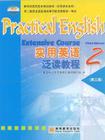实用英语泛读教程.2
2008-1
高等教育
本社
97
《实用英语》是一套供高等专科学校使用的英语教材。本教材的编写以国家教育委员会1993年颁发的《普通高等专科英语课程教学基本要求》为依据。《基本要求》规定:普通高等专科英语课程教学的目的是,培养学生掌握必需的、实用的英语语言知识和技能,具有阅读和翻译与本专业有关的英文资料的初步能力,并为进一步提高英语的应用能力打下一定的基础。 为了体现上述教学目的,在编写《实用英语》过程中我们既注意吸收现代外语教学理论中适合我国英语教学实际的某些现点,又采纳传统外语教学的某些合理部分,结合我国外语教学中行之有效的理论和方法及现状,力求正确处理好语言基础和语言应用的关系,突出加强语言能力的培养和实际运用,最终达到使学生通过两年的学习,具有阅读和翻译与本专业有关的英文资料的初步能力,并为今后进一步提高英语的应用能力打下一定的基础。 《基本要求》将专科英语课程教学分为两个阶段:第一阶段应重视语言共核教学,培养基本的语言技能,第二阶段应结合专业,强调基本的阅读和翻译技能在本专业的实际应用。为了体现这一教学安排,本套教材也分成两个阶段。第一阶段包括《综合教程》和《泛读教程》各3册,第二阶段包括《实用业务英语》1册。《综合教程》和《泛读教程》是《实用业务英语》的基础,并在教学内容、技能培养方面逐渐向《实用业务英语》过渡,《实用业务英语》是《综合教程》和《泛读教程》的总结和提高,并结合学生毕业后使用英语的需要,侧重于实用文体的阅读和翻译、实用英语口语的训练和实用文体模拟写作方面的训练。
《实用英语泛读教程2(非英语专业用)》是一套专科层次的公共英语教材,是教育部规划的高职高专英语教材。本套教材1995年正式出版发行,1999年至2000年进行了第一次修订。为了更加有利于学生英语应用能力的培养.结合这几年《实用英语》的教学使用反馈,修订组以教育部2000年颁发的《高职高专教育英语课程教学基本要求(试行)》为依据,对《实用英语》进行了第二次修订。 《实用英语泛读教程(2非英语专业用)》是《实用英语泛读教程2》第三版,全书共有8个单元,每单元分A、B、C三篇文章。文章A为重点泛读材料,供课堂上使用;文章B为快速限时阅读材料,既可在课堂上使用,也可在课后由学生独立完成;文章c为课外阅读材料。 《实用英语泛读教程(2非英语专业用)》第二版曾获2002年全国高等学校优秀教材一等奖。
1 Passage A: Communications of the FuturePassage B: "High Tech" and "State of the Art"Passage C: Whats So Good About the Information Age?2 Passage A: Protection for Consumers in USAPassage B: Getawy People Use XYZ PetrolPassage C: Scan This Web Site3 Passage A: Buses Are Good Test of VirtuePassage B: Get the Job You Want (Speed Reading)Passage C: Job Hunting4 Passage A: Making a Cultural ChangePassage B: The British Family Life (Speed Reading)Passage C: The Sacred "Rac"5 Passage A: How to Tell If Someone Is LyingPassage B: My Educational Experience at IllinoisPassage C: Dont Believe Everything You Hear6 Passage A: The Email MurdererPassage B: Television: How It Affects Us (Speed Reading)Passage C: When the Computer Is Down7 Passage A: Animal EducationPassage B: Talk to the Animals (Speed Reading )Passage C: Tobermory: The Talking Cat8 Passage A: The Virtue Called DevotionPassage B: Clone Ewe, but Not YouPassage C: Personal RelationshipsGlossaryPhrases and ExpressionsKey to the Exercises
"High tech" and =state of the art" are two expressions to describe very modern technology.High tech is just a shorter way of saying high technology, and high technology describes anyinvention, system or device that uses the newest ideas or discoveries of science and engineering. What is high tech? A computer is high tech. So is a communication satellite. A modernmanufacturing system is surely high tech. The opposite of high tech is low tech. As you mightimagine, low tech describes technology that is traditional, simple and easy to operate. A woodenplow pulled by oxen is low tech. So is a hand pump. High tech became a popular expression inthe United States during the early 1980s. Because of the improvements in technology people couldbuy many new kinds of products in American stores. Product like small powerful home computers,low cost microwave ovens for cooking food quickly, modern music systems that use a digitalelectronic system for recording sounds. The companies that make these products were proud oftheir goods. They wanted everyone to know that their products were as modern as possible. So inall kinds of advertising, companies described their products as high tech. Soon everyone knew theexpression. State of the art is something that is as modern as possible. It is a product that is basedon the very latest methods and technology. Something that is state of the art is the newest possibledesign or product of business or industry. A state-of-the-art television set, for example, uses the mostmodern electronic design and parts. It is the best that one can buy.
